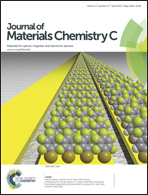Moisture-induced degradation and its mechanism of (Sr,Ca)AlSiN3:Eu2+, a red-color-converter for solid state lighting†
Abstract
(Sr,Ca)AlSiN3:Eu2+ (SCASN) is a very promising red phosphor used as a down-conversion luminescent material in solid state lighting. In this study, the moisture-induced degradation of SCASN was comprehensively investigated by treating it under severe conditions with high-pressure water steam. The degradation initiated at 150 °C, and the luminescence of SCASN was quenched quickly, with the powder sample being bleached after the treatment. Both the microstructure and phase changed obviously with oxidation, and the host turned finally into NH3, (Sr,Ca)Al2Si2O8 and Ca(OH)2. Using a variety of spectroscopic, surface and microstructure analytical techniques, the degradation mechanism was clarified and proposed to occur via the oxidant-gas penetration mechanism through the moisture-enhanced oxidation of both the SCASN host and divalent europium. The activation energy for the moisture-induced degradation was about 66.32 kJ mol−1.


 Please wait while we load your content...
Please wait while we load your content...